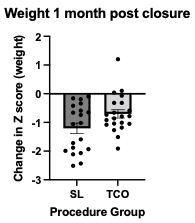Neonatal General
Category: Abstract Submission
Neonatology General 9: Congenital Anomalies - CV
309 - Surgical PDA Ligation versus Transcatheter PDA Occlusion Effect on Growth
Monday, April 25, 2022
3:30 PM - 6:00 PM US MT
Poster Number: 309
Christina Callas, University of California Davis Children's Hospital, Sacramento, CA, United States; Tynisha Koenigsaecker, University of California Davis Children's Hospital, Sacramento, CA, United States; Catherine A. Rottkamp, University of California Davis, Sacramento, CA, United States; Frank Ing, University of California Davis Children's Hospital, Sacarmento, CA, United States; Steven McElroy, UC Davis, Sacramento, CA, United States

Christina Callas, MD
Resident
University of California Davis Children's Hospital
Sacramento, California, United States
Presenting Author(s)
Background: The optimal management of the patent ductus arteriosus (PDA) in premature infants remains uncertain. Early, routine PDA closure with medication or surgical ligation in preterm infants has not been shown to improve long-term outcomes (Mosalli 2008). In recent years, several trials have demonstrated successful and safe transcatheter PDA occlusion in premature infants, which represents a less invasive closure method compared to surgical intervention (Fraisse 2020). Whether transcatheter PDA occlusion represents a shift in PDA management that will result in improved short- and long-term outcomes remains to be seen.
Objective: In this study, we aim to evaluate if there is a significant difference between transcatheter occlusion (TCO) and surgical ligation (SL) on short-term growth, including weight, length, and head circumference, at one month post-PDA closure.
Design/Methods: A retrospective chart review of patients admitted to the Neonatal Intensive Care Unit at UC Davis Children’s Hospital who received either surgical ligation or transcatheter occlusion between 2013 and 2019 was completed. Patients were excluded for the following: birth weight greater than 1500 grams, gestational age greater than 31 weeks, other congenital heart disease, and discharge or transfer prior to 1 month following closure. Data from 20 patients who underwent surgical ligation and 21 patients who underwent transcatheter occlusion was obtained. Age at time of procedure was compared. Using Fenton growth curves, z-scores for weight, length and head circumference were obtained at time of birth, time of closure, and one month following closure.
Results: There was no difference in mean age at time of closure for the two groups (Figure 1). A Student’s T test was performed to examine the relationship between surgical ligation and transcatheter occlusion (measured as change in z-score from time of birth) for growth parameters (weight, length, and head circumference) from birth to time of closure and one month following closure. For all growth parameters, there was no difference between groups at time of closure. For weight at one month following closure, the mean change in z-score for the surgical ligation group was -1.208, and for transcatheter occlusion group was -0.702 (p=0.035) (Figure 2). Difference between groups for length and head circumference at one month post-closure was nonsignificant. Conclusion(s): For short term growth post-PDA closure, patients who received transcatheter occlusion had improved weight gain compared to those who underwent surgical ligation. There is no significant difference for length or head circumference.
Figure 2 1 month post closure weights with SEM error bars for surgical ligation (SL) and transcatheter occlusion (TCO) patients
1 month post closure weights with SEM error bars for surgical ligation (SL) and transcatheter occlusion (TCO) patients
Figure 1.png) Mean days of life at time of PDA closure was 36.4 days for surgical ligation (SL), 37.2 days for transcatheter occlusion (TCO)
Mean days of life at time of PDA closure was 36.4 days for surgical ligation (SL), 37.2 days for transcatheter occlusion (TCO)
Objective: In this study, we aim to evaluate if there is a significant difference between transcatheter occlusion (TCO) and surgical ligation (SL) on short-term growth, including weight, length, and head circumference, at one month post-PDA closure.
Design/Methods: A retrospective chart review of patients admitted to the Neonatal Intensive Care Unit at UC Davis Children’s Hospital who received either surgical ligation or transcatheter occlusion between 2013 and 2019 was completed. Patients were excluded for the following: birth weight greater than 1500 grams, gestational age greater than 31 weeks, other congenital heart disease, and discharge or transfer prior to 1 month following closure. Data from 20 patients who underwent surgical ligation and 21 patients who underwent transcatheter occlusion was obtained. Age at time of procedure was compared. Using Fenton growth curves, z-scores for weight, length and head circumference were obtained at time of birth, time of closure, and one month following closure.
Results: There was no difference in mean age at time of closure for the two groups (Figure 1). A Student’s T test was performed to examine the relationship between surgical ligation and transcatheter occlusion (measured as change in z-score from time of birth) for growth parameters (weight, length, and head circumference) from birth to time of closure and one month following closure. For all growth parameters, there was no difference between groups at time of closure. For weight at one month following closure, the mean change in z-score for the surgical ligation group was -1.208, and for transcatheter occlusion group was -0.702 (p=0.035) (Figure 2). Difference between groups for length and head circumference at one month post-closure was nonsignificant. Conclusion(s): For short term growth post-PDA closure, patients who received transcatheter occlusion had improved weight gain compared to those who underwent surgical ligation. There is no significant difference for length or head circumference.
Figure 2
 1 month post closure weights with SEM error bars for surgical ligation (SL) and transcatheter occlusion (TCO) patients
1 month post closure weights with SEM error bars for surgical ligation (SL) and transcatheter occlusion (TCO) patientsFigure 1
.png) Mean days of life at time of PDA closure was 36.4 days for surgical ligation (SL), 37.2 days for transcatheter occlusion (TCO)
Mean days of life at time of PDA closure was 36.4 days for surgical ligation (SL), 37.2 days for transcatheter occlusion (TCO)